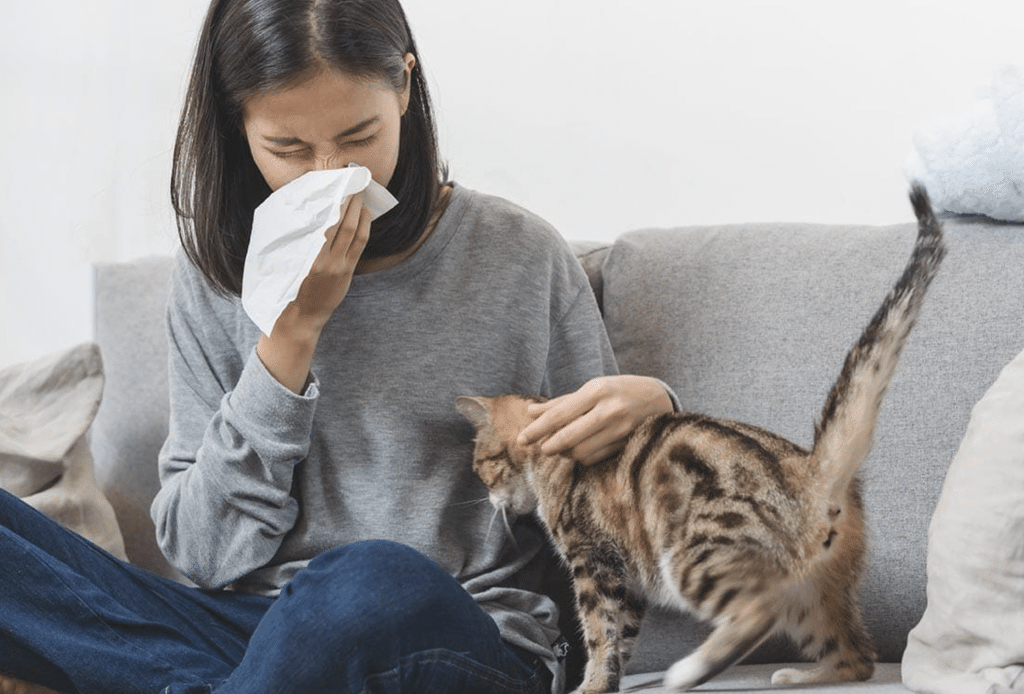Cat allergies can be a serious problem for both cats and humans. They can cause discomfort, allergic reactions, and even severe health problems. It’s essential to understand the causes, symptoms, and treatments of cat allergies to manage them effectively and maintain your cat’s health.
Causes of Cat Allergies
Cat allergies are caused by an immune system response to allergens, which are substances that trigger an allergic reaction. The most common allergen associated with cat allergies is a protein found in the cat’s saliva, urine, and dander (dead skin cells). When these allergens come into contact with a sensitive person’s or pet’s immune system, it triggers an allergic reaction. Here are some common causes of cat allergies:
- Fel d 1 Protein – This protein is found in a cat’s saliva, skin, and urine. When a cat grooms itself, it spreads the protein all over its coat. When the protein is released into the air, it can trigger an allergic reaction in some people.
- Dander – Dander is made up of tiny flakes of skin shed by cats. These flakes can become airborne and spread throughout the environment, causing allergic reactions in sensitive individuals.
- Urine – When a cat urinates, it releases allergens that can become airborne and cause an allergic reaction in some people.
- Saliva – When a cat licks itself, it spreads the saliva all over its fur. When the saliva dries, it can become airborne and cause an allergic reaction.
- Breed – Certain cat breeds are more likely to cause allergic reactions than others. Breeds that produce less of the Fel d 1 protein, such as Sphynx, Devon Rex, and Cornish Rex, may be better tolerated by people with cat allergies.
It’s important to note that cat allergies are not caused by cat hair itself, but rather by the proteins found in the cat’s saliva, urine, and dander. Additionally, some people may be more susceptible to cat allergies due to genetic factors, while others may develop allergies over time with prolonged exposure to cats.
Symptoms of Cat Allergies in Humans
The most common symptoms of cat allergies in humans are sneezing, runny nose, itchy or watery eyes, and coughing. Some people may also experience skin rash, hives, or asthma. These symptoms can range from mild to severe, and they can be triggered by direct contact with cats, exposure to cat hair or dander, or even being in a room where a cat has been.
It’s essential to differentiate cat allergies from other allergies as they may have different triggers and symptoms. For example, pollen allergies tend to cause more respiratory symptoms like wheezing and shortness of breath, while food allergies may cause gastrointestinal symptoms like nausea and diarrhea.
Symptoms of Cat Allergies in Cats
Just like humans, cats can also suffer from allergies. The most common symptoms of cat allergies are skin irritation, itching, and hair loss. Cats may also have respiratory symptoms like sneezing, coughing, or runny nose. In some severe cases, allergies can lead to secondary infections or even life-threatening conditions like anaphylaxis.
Diagnosis of Cat Allergies
If you suspect that you or your cat has an allergy, it’s essential to visit an allergist or a veterinarian for a proper diagnosis. They may perform skin tests, blood tests, or elimination diets to identify the allergen that is causing the reaction. This information is crucial to develop an effective treatment plan.
Treatment of Cat Allergies in Humans
The most common treatment for cat allergies in humans is the use of antihistamines. These medications block the histamine that is produced by the immune system, reducing the symptoms of the allergic reaction. Other treatment options include nasal sprays, decongestants, and allergy shots.
In addition to medication, it’s essential to manage cat allergies by keeping the environment clean and free of allergens. This includes vacuuming regularly, using air purifiers, and washing bedding and curtains regularly.
Treatment of Cat Allergies in Cats
The treatment of cat allergies in cats can vary depending on the severity and the cause of the allergy. Medication like corticosteroids or antihistamines may be prescribed to relieve the symptoms. In other cases, topical treatments like shampoos or ointments may be used to soothe the skin.
Identifying and removing the allergen is also an essential part of treating cat allergies. This may involve changing the cat’s diet, using hypoallergenic products, or eliminating potential allergens from the environment.
Cat Health Tips
Cats require regular grooming and care to maintain their health and reduce the risk of allergies. Here are some cat health tips that can help prevent or manage cat allergies:
- Regular Grooming – Brushing and bathing your cat regularly can help remove loose hair and reduce the amount of dander in the environment.
- Hypoallergenic Products – Using hypoallergenic products, like litter, food, and grooming supplies can help reduce the risk of allergic reactions.
- Clean Environment – Regularly cleaning your home, including vacuuming and dusting, can help reduce the number of allergens in the environment.
- Air Purifier – Using air purifiers with HEPA filters can help capture allergens and reduce the risk of allergic reactions.
- Regular Check-Ups – Regular visits to the veterinarian can help identify any health problems early and prevent them from worsening.
Cat allergies can be a significant problem for both cats and humans, but with proper management and care, they can be effectively managed. Understanding the causes, symptoms, and treatment options is crucial for managing cat allergies effectively.
By following the tips and guidelines provided in this guide, you can ensure the health and well-being of your cat and reduce the risk of allergic reactions in yourself and others. Consult with a doctor or veterinarian if you suspect you or your cat has an allergy to identify the allergen and develop an effective treatment plan.

